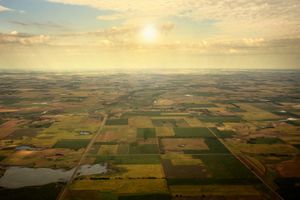Farmland Values Steady Amid Shift to Online Auctions
 As many land auctions have moved online over concerns of the spread of COVID-19, prices for quality farmland have appeared to remain strong.
As many land auctions have moved online over concerns of the spread of COVID-19, prices for quality farmland have appeared to remain strong.
Last week, R.D. Schrader, president of Schrader Real Estate and Auction Company based in Indiana, shared real-time sales results, to help indicate how the pandemic is affecting farmland prices.
Licensed in 29 states, Schrader conducted the first online, multi-tract auction on the internet simultaneously with a live auction back in March 2000. Today, due to COVID-19, more sellers have been taking advantage of Schrader’s ability to provide simulcast bidding as well as timed online sales.
Schrader said there are several factors contributing to recent land prices like tight supplies, favorable interest rates and 1031 exchange money. Also known as like-kind exchanges, the 1031 exchange money has been playing an especially important role in motivating buyers as there is a financial impetus (avoiding a premium on capital gains for those funds) to reinvest within the limited timeframe (180 days to close).
Farmland prices continue to be location dependent and are tied to better quality land, Schrader said. Over the past decade, a shift in who is buying farmland has also helped support the market.
“From 2004 to 2005, about 40% of buyers were investors and 55% were operators,” said Schrader, referring to a data-set showing buyers of Iowa farmland. Beginning around 2010, those statistics show existing farmers becoming the dominant buyers, at 70% to 80%.
Schrader shared recent large-acreage sales by his company, which showed strong prices for row crop farms from the last quarter of 2019 and into the first quarter of 2020.
In March and April of this year, he noted five separate sales where per-acre prices ranged from $5,000 to as much as $27,000 per acre. These auctions all took place during what Schrader marked as the “Coronavirus Period.” They included sales in Dane County, Wisconsin, where 22 registered bidders took per-acre prices to $9,600; Madison County, Ohio, 16 bidders, $8,800 per acre; and Fayette County, Ohio, 38 bidders, between $5,000 and $10,000 per acre based on the tract.
Comparing these sales to some earlier examples, there doesn’t seem to be much, if any, slippage in prices, Schrader said.
In November 2019, an 805-acre property in Union County, Indiana, was offered in 11 tracts. It sold for prices ranging from $4,081 up to $8,984 per acre. There were 71 registered bidders and a lot of competition. Schrader noted 1031 money played a role, where five buyers needed to get invested.
In February 2020, a 234-acre property in Franklin County, Indiana, was offered in five tracts. It sold for $10,745 per acre. There were 43 bidders and an investor paid the top price, which Schrader said was pushed over the $10,000 mark by competition among area farmers.
Schrader said he is watching whether the pandemic will reduce 1031-exchange money in the land market as well as the oil market’s impact on the overall economy. He said there are also concerns as to how the pandemic impacts China-U.S. trade agreements moving forward.
Cash flow will be especially important this season, he said. Lenders will want to see “reasonable” operating loans and some will be reluctant to lend for land purchases. Overall, lenders work on a case-by-case basis and some may be extra conservative in these uncertain times. Highly leveraged individuals will likely struggle with these additional pressures.
Schrader said he expects land to continue to be a favored tool for diversification by investors due to historically low volatility when compared to other investments.
Source: Victoria Meyers, DTN
